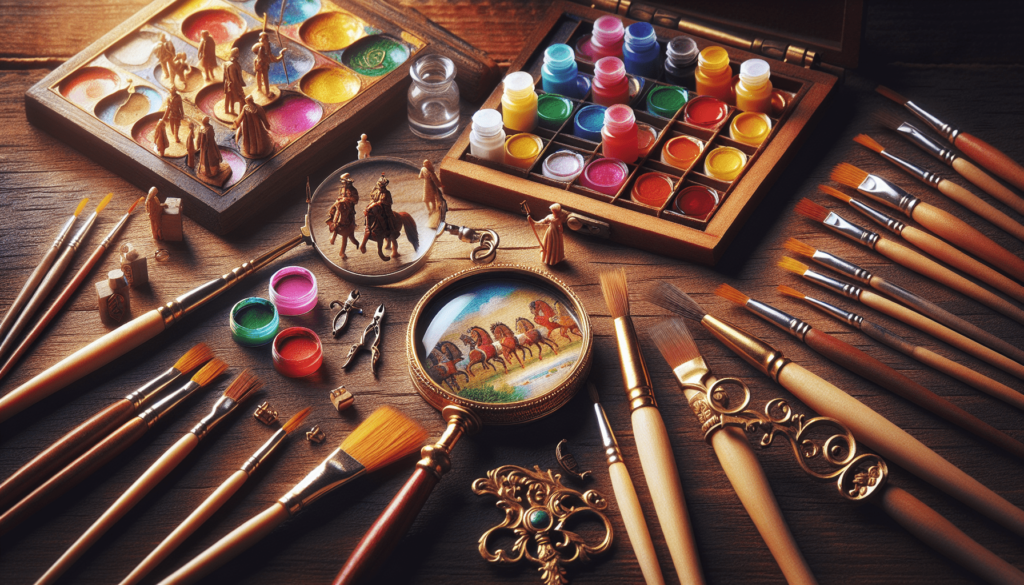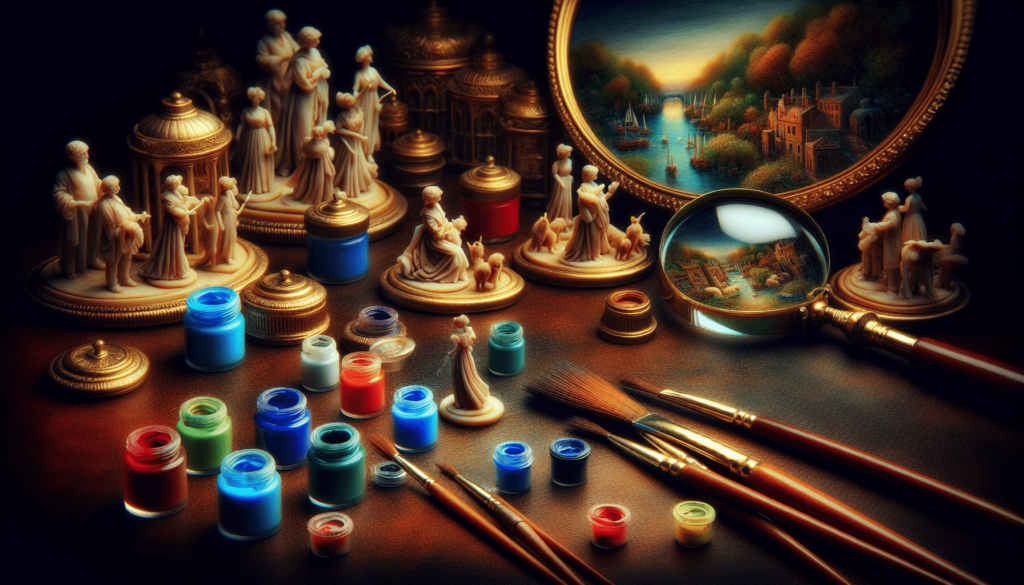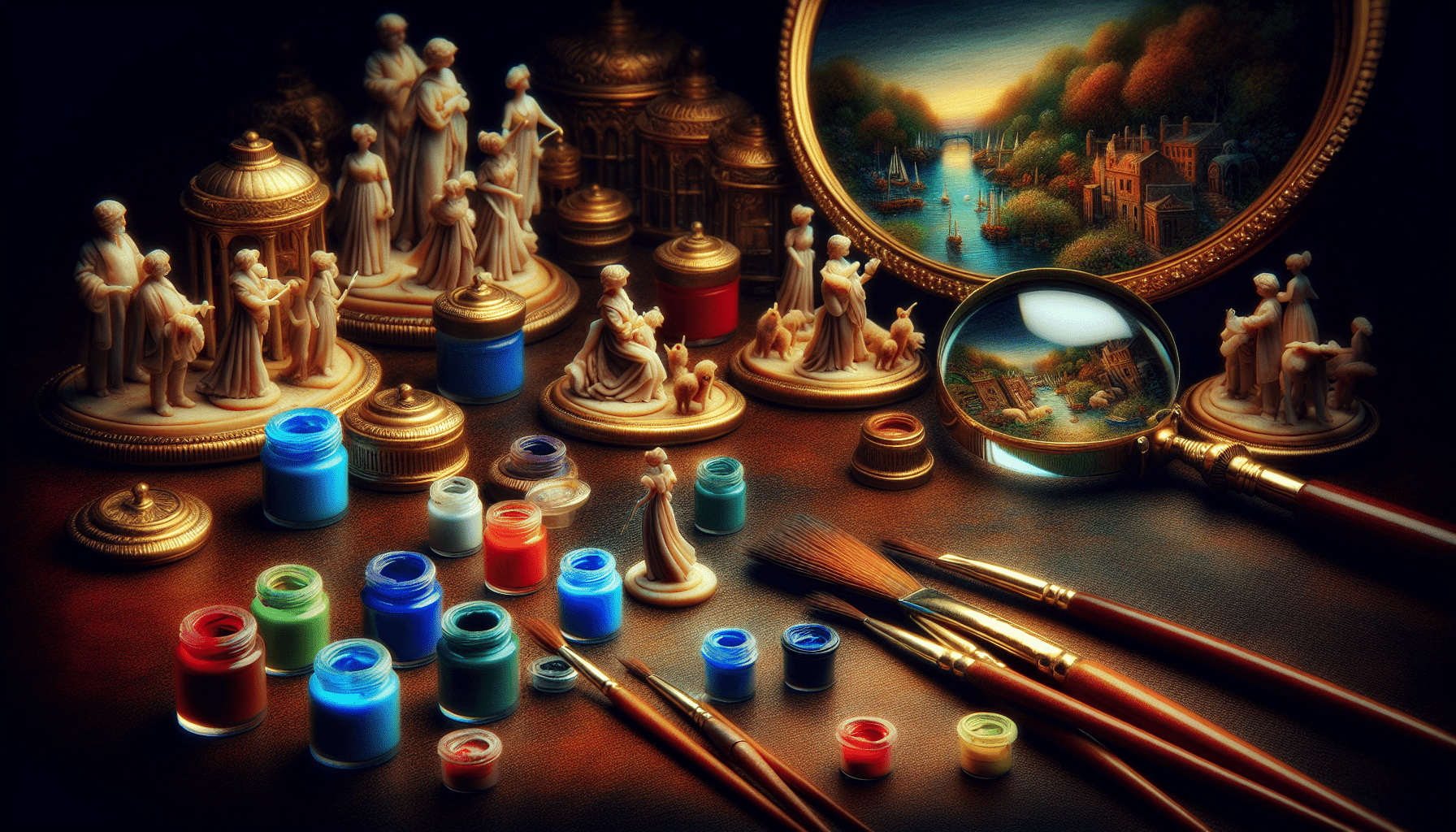Are you fascinated by the art of miniature painting but unsure about the tools and materials required to bring your own tiny masterpieces to life? Look no further! In this article, we will provide you with a comprehensive list of everything you need to get started on your miniature painting journey. From brushes and paints to primers and sealers, we’ve got you covered. So grab your paint palette and prepare to unleash your creativity in miniature form!

Tools
Paintbrushes
Paintbrushes are essential tools for miniature painting. They come in various sizes and shapes, allowing for different brush strokes and detailed work. It is recommended to have a selection of brushes, including small detail brushes for intricate work and larger brushes for broader strokes.
Palette
A palette is used to hold and mix paints. It provides a flat surface for mixing colors and allows for easy access to the paints during the painting process. Palettes can come in different materials such as plastic or glass. Consider choosing a palette with separate wells for each color to keep the paints organized.
Painting handles
Painting handles, also known as painting grips or holders, are ergonomic tools used to hold miniature figures or small objects while painting. They provide a comfortable grip and allow for greater control and stability during the painting process. Look for handles that can securely hold your miniatures or objects in place.
Magnifying lamp
A magnifying lamp is a useful tool for miniature painting, especially for those who require additional magnification for fine details. The lamp combines a light source with a magnifying lens, making it easier to see and work on intricate areas. Choose a magnifying lamp with adjustable brightness and a sturdy base to ensure optimal visibility.
Airbrush
An airbrush is not a necessity for beginners, but it can be a valuable tool for advanced miniature painters. It uses compressed air to spray paint onto the surface, allowing for smooth and controlled application. Airbrushing is particularly useful for achieving gradient effects and large-scale projects. Consider investing in an airbrush if you plan to take your miniature painting to the next level.
Paints
Acrylic paints
Acrylic paints are water-based and versatile, making them a popular choice among miniature painters. They dry quickly, allowing for easier layering and blending. Acrylic paints come in a wide range of colors and can be thinned with water or acrylic medium for different effects. They are also easy to clean up with water and are generally non-toxic.
Enamel paints
Enamel paints are oil-based and provide a durable and glossy finish. They are known for their vibrant colors and ability to withstand wear and tear. Enamel paints require longer drying times and can be thinned with enamel thinner or white spirit. It is important to work in a well-ventilated area when using enamel paints due to the fumes.
Oil paints
Oil paints are highly pigmented and have a longer drying time compared to other types of paints. They offer a unique richness and blending capabilities, making them a favorite among traditional painters. Oil paints can be thinned with linseed oil or other oil painting mediums. However, they require careful handling and longer drying times, so they may not be ideal for quick projects.
Watercolor paints
Watercolor paints are transparent and known for their delicate and translucent qualities. They are commonly used for landscapes and wash techniques. Watercolor paints can be mixed with water for different effects, from subtle washes to bold colors. They are generally quick-drying, allowing for layering and glazing techniques in miniature painting.
Primer
Spray primer
Spray primer is a convenient and popular choice for priming miniatures. It comes in aerosol cans and provides an even and smooth base for painting. Spray primers are quick to apply and dry quickly, ensuring that the paint adheres well to the miniature surface. Choose a spray primer specifically formulated for miniature painting for the best results.
Brush-on primer
Brush-on primer is applied with a paintbrush and provides more control over the priming process. It allows for precise application, especially on small details or hard-to-reach areas. Brush-on primer comes in various colors, including white, gray, and black, depending on the desired base color for your miniature. It is important to let the primer dry thoroughly before painting to ensure proper adhesion.
Thinning Mediums
Water
Water is the most accessible and commonly used thinning medium for acrylic and watercolor paints. It can be used to dilute the paint for lighter washes or to thin the paint consistency for smoother application. Adding water gradually allows for better control over the paint’s consistency and opacity. It is important to note that too much water can affect the paint’s adhesion and color intensity.
Isopropyl alcohol
Isopropyl alcohol, also known as rubbing alcohol, can be used as a thinning medium for acrylic paints. It helps to break down the paint pigments and improve flow. Isopropyl alcohol evaporates quickly, allowing for faster drying times. It is recommended to use isopropyl alcohol in small amounts and test it on a spare piece of material to ensure it does not negatively affect the paint’s properties.
Paint thinner
Paint thinner is commonly used with oil-based paints. It helps to reduce the viscosity of the paint, making it easier to work with. Paint thinner can also be used for cleaning brushes and other painting tools. It is important to use paint thinner in a well-ventilated area and follow the manufacturer’s instructions for proper usage and disposal.
Painting Surface
Miniature figure
A miniature figure is the primary surface for miniature painting. It can be made of various materials such as plastic, metal, or resin. Plastic figures are widely available and are a popular choice for beginners due to their affordability. Metal and resin figures offer more detailed sculpts and are often used by advanced painters. Choose a miniature figure that suits your skill level and painting style.
Canvas
Canvas is a versatile painting surface that can be used for different types of painting, including miniature painting. It provides a textured surface that adds depth and interest to the artwork. Canvas can be stretched on a frame or purchased as canvas panels. It is important to choose a canvas with a suitable size for your miniature painting project.
Paper
Paper is another option for miniature painting, particularly for watercolor and gouache techniques. Watercolor paper is designed for water-based paints and can withstand a certain amount of water without warping or tearing. Look for paper that is specifically labeled for watercolor or gouache painting, with a suitable weight and texture for your desired painting style.
Cleaning Supplies
Paintbrush cleaner
A paintbrush cleaner is essential for maintaining the longevity of your paintbrushes. It effectively removes paint residue and helps prevent bristle damage. Paintbrush cleaner can be in the form of a liquid or soap bar. It is important to clean your brushes thoroughly after each painting session to ensure optimal performance and extend their lifespan.
Cotton swabs
Cotton swabs, also known as cotton buds, are useful for cleaning small and intricate areas of your miniature figures. They can be dipped in paint thinner or water to remove excess paint or correct mistakes. Cotton swabs are cheap and disposable, making them a handy tool for precise cleaning tasks.
Lint-free cloths
Lint-free cloths are used for wiping brushes or surfaces during the painting process. They help to remove excess paint or moisture, ensuring clean and even brushstrokes. Lint-free cloths are made of materials that do not shed fibers, preventing unwanted debris from mixing with the paint. These cloths can also be used for drying brushes after cleaning.

Masking Materials
Masking tape
Masking tape is used to create clean and precise lines in miniature painting. It can be applied to areas that need to be protected from paint or to create sharp edges between different colors. Masking tape comes in various widths, allowing for flexibility in design choices. It is important to remove the masking tape carefully to avoid damaging the painted surface.
Liquid mask
Liquid mask, also known as masking fluid, is a liquid that can be applied to specific areas of a miniature figure to protect them from paint. It creates a temporary barrier that can be peeled off after painting. Liquid mask is particularly useful for masking small details or intricate patterns. It is important to let the liquid mask fully dry before applying paint to ensure clean lines.
Mixing and Storage
Mixing palette
A mixing palette is used for mixing and creating custom colors. It provides a flat and non-absorbent surface that makes it easy to blend paints together. A mixing palette can be made of various materials such as plastic or glass. Look for a palette with wells or compartments to keep the different paint colors separate and organized.
Paint pots
Paint pots, also known as paint bottles or dropper bottles, are used to store and dispense paints. They are particularly useful for saving and organizing custom-mixed colors. Paint pots come in different sizes and materials, such as plastic or glass. Consider choosing paint pots that are compatible with the type of paint you use and have a secure seal to prevent drying out.
Storage boxes
Storage boxes are essential for keeping your miniature painting supplies organized and protected. Look for boxes with compartments or adjustable dividers to keep different tools and materials separate and prevent damage during transportation. A sturdy and stackable storage box will help keep your painting area clutter-free and ensure that everything is easily accessible when needed.
Finishing Materials
Varnish
Varnish is a protective coating that is applied to miniature figures once the painting is completed. It helps to protect the paint from dust, scratches, and fading. Varnish can come in various finishes, such as matte, satin, or gloss. Choose a varnish that suits your desired final look and apply it evenly with a soft brush or airbrush.
Sealer
A sealer is similar to varnish but is applied before the painting process. It helps to create a layer between the miniature surface and the paint, ensuring better adhesion and reducing the risk of chipping or peeling. Sealer can come in different formulations, such as matte or glossy. It is important to follow the manufacturer’s instructions for proper application and drying times.
Brush-on gloss
A brush-on gloss is a clear, liquid medium that provides a glossy finish to specific areas of a miniature figure. It can be applied selectively to create highlights or to enhance certain details. Brush-on gloss can be used with various paints, such as acrylics or enamels. It is important to let the gloss fully dry before handling the miniature to avoid smudging or fingerprints.
Optional Tools
Sculpting tools
Sculpting tools are used for modifying or sculpting miniature figures. They are particularly useful for advanced painters who want to customize or add additional details to their miniatures. Sculpting tools can include various types of sculpting clay, carving knives, and shaping tools. It is recommended to have some basic sculpting tools if you are interested in advanced miniature painting techniques.
Air compressor
An air compressor is a tool used in conjunction with an airbrush. It provides the necessary compressed air for the airbrush to function properly. An air compressor allows for greater control and efficiency in airbrushing techniques. If you plan to incorporate airbrushing into your miniature painting, consider investing in an air compressor that is suitable for your specific needs.
Miniature holder
A miniature holder is used to securely hold miniature figures while painting. It can prevent smudging or damage to the painted surface by allowing you to grip the miniature without touching the painted areas. There are various types of miniature holders available, including adjustable holders or clamps that can be attached to a work surface. Choose a holder that is compatible with the size and material of your miniatures.

Leave a Reply